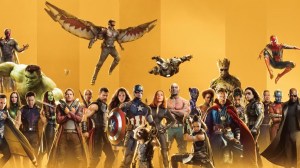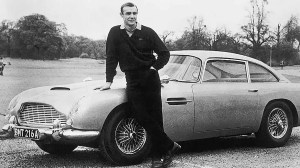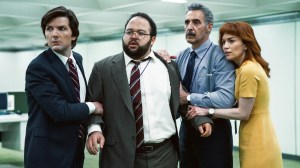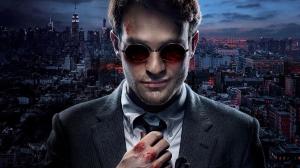With the rise of superhero cinema, scientists have become some of our greatest heroes. Take Marvel’s “Science Bros,” Tony Stark and Bruce Banner.
Videos by ComicBook.com
And yet, it isn’t often that most people sit down across the table from each other during a coffee date and start discusses the latest findings from the scientific community.
Having been on one side of that dichotomy, Dr. Clifford Johnson is looking to remedy the other side. Johnson has worked as a science consultant on several films and television series, including mutliple projects for Marvel. He’s also created a graphic novel titled The Dialogues that shows how regular peolpe could make science a part of their regular, everday conversational diet.
ComicBook.com spoke to Johnson about the book and his work behind the scenes in Hollywood.
****
ComicBook.com: Tell me a bit about your book, The Dialogues.
Dr. Clifford Johnson: Well, the big picture is that I’m trying to get people excited about science. There’s so much going on and it’s a really exciting thing that I hope people engage with like they engage with any other part of the culture. To that aim, I was trying to maybe do something a little different from the usual kind of science book that an academic might write because that’s not to everyone’s taste. So, I was trying to sort of broaden things a bit. So, instead of it discussing the ideas entirely in terms of prose, of words, I was trying to have people engage in a way that maybe they’re not used to but I think there should be more of. So, instead of having the word from the academic about how you’re supposed to think about things, instead, you eavesdrop on conversations between people out there in the world. I thought that might actually be a little more interesting to some people’s tastes, just a little bit of a change from how things are done. Not that there’s anything wrong with those other ways of doing things. I just think it’s an option to broaden things a bit.
And then it’s very visual. It’s actually a graphic book, so you actually see the people who are having the conversations and you see where they are. Hopefully, that draws you in a little bit into what they’re saying and why they’re saying what they might be saying. And you still engage with the ideas. So, that’s the setup.
Explaining Science Visually
Do you find that ideas like those in physics are naturally easier to communicate visually than verbally?
Well, “easier” isn’t the word I would use. I mean, sometimes it is. But the point is that there really isn’t anything wrong with a book with just words, of course. And that’s not what I’m saying. What I’m saying is that there are other modes of thinking, there are other modes of engaging with ideas. And sometimes when you use other ways of bringing out ideas, you find different ways and, yeah, sometimes better ways of connecting with the idea or helping people connect with the idea. So, I hope that people who read the other kinds of science book will very naturally find this way is also for them as well. It’s not meant to replace the other ways of doing things. Just to give more options, if you like.
Among those options are, yes, things like space and time actually have a very, very natural place the language of comics. The language of graphic narratives. Because you as the reader create space and time as you’re reading the comic. So, that’s a very active way of engaging. And so when you’re aware of that, as a comic creator, you can actually play with that. You can actually use that as one of the tools to help get certain ideas across. So that’s what I do in some parts of the book.
Origin Story

How did you come to the idea of making this unorthodox science book? Was it a slow development over time? Was there a “eureka” moment?
Well, it came slowly over time and I didn’t realize that that’s what I was creeping toward. And then I did have a eureka moment when I suddenly realized what it was I was doing. And then it became extremely clear. So, I had the actual idea for a book of dialogues over 18 years ago. The idea was that it seemed to me that what was missing literature is a more if you like, a reader-centric way of presenting the material. So, like I said, instead of it being sort of a single voice telling you what’s been going on in the field and how you’re supposed to think about stuff, which is a fine way of doing things, instead of that, what you end up doing is putting the science and the ideas in the mouths of ordinary people out there in the world.
So, that was the core idea. But it was still going to be more of a prose book. And then I thought, “It’d be nice to have a few illustrations, maybe showing a little bit about what they might be scribbling on a napkin while they were having those conversations.” And then, over the years, I would sort of revisit the idea. Because I was working on other stuff. And every time I revisited, I realized that the actual visual component kind of grew. I thought, “Well, it’d be great to actually see the people. You might sort of relate to them if you could see who they were.” And you’d be wondering how they came to meet and stuff like that. And then, “Oh, it’d be fun to show where they are. You know, they’re not just sitting in a lab talking about science, they’re out there in the world, in a café, at a party, just like everybody else.” But also talking about science, as people do.
So, I was trying to celebrate the fact that you have real science conversations going on between regular people out there in the world but no one really shines a spotlight on that. So, that was the idea. And then I realized more and more that I should show more of that, rather than just saying that that happens, as it were. And then, at some point, it dawned on me, around 2006 or something like that. “Oh my goodness, I should be just doing this as a narrative visual thing.” And, “Oh, it’s a graphic novel. I like those. Why are there no books like this out there?” You know?
I did a bit of research and realized no one’s done this. And I was sort of blown away by the fact that this just seemed like suddenly a really obvious thing that should’ve been done a long time ago. And no one had been doing that. And then, moreover, there was just this urgency to, “Well, I just have to do it. This is the idea. This is the book, the kind of book I want to see in the world. So I should bring it into the world.” And so that was the long process of 18 years. And only about halfway through that 18 years did I realize what it is I was doing.
Conversational Science
Why do you feel it is important for science to be a part of people’s normal, everyday conversations?
That’s a great question. And it’s really, really simple. It’s the idea that science belongs to everybody. It doesn’t belong to the scientist. You know, we’re the professionals who might be involved in uncovering new understandings and things like that. But science itself, the process of science and the product of science belong to everybody. And it’s part of human culture.
If you can do any other part of human culture, whether it be music or poetry or painting or photography or any of those things, we all engage with it. We don’t just go, “Oh, I’m not gonna take a picture ’cause that’s- professional photographers do that.” You know? That’s ridiculous, right? The same thing should be true for science. Encouraging people to just go, “Look, I own this as part of the human culture on this planet. Science is as fair game as anybody else.” And we engage with all the other stuff. We talk about photography, we take pictures. We talk about politics. We talk about what’s going on in the gossip tabloids, or whatever. All of that’s part of culture, pop culture and what have you.
What I’m saying is you should be able to just mix in anything you like and science should be part of that. On the one hand, you could be talking about the royal wedding or whatever, who’s getting married to who in celebrity culture and then switch it up and talk about the latest rocket launch that happened last week. Or the fact that we can now detect black holes colliding into each other billions of light years away. That’s’ just amazing because the stuff we’re made of is made in some of those collisions. You know, things like that. It’s amazing. I’m just sort of going, hey, there’s a whole bunch of stuff that is exciting and interesting that people are told by the culture and the media that is only stuff for specialists. Or if you’re into it, you’re a nerd, or whatever. Just ignore that. Just engage with it like anything else.
Science on Screen

You’ve done a lot of work as a science consultant on movies and television shows. What are some of projects you’ve worked on where you’ve been surprised by how close or how far the project was in relation to getting the science right?
What I’m going to say is maybe going to surprise you. Let me just say that not all science consultants agree with this, but I actually don’t think our most important role is to be a fact checker. In fact, that often sometimes is one of the reasons why a lot of stuff doesn’t end up being a huge success, on the scientific side, in entertainment, because we’re regarded like we’re supposed to come in and give the filmmakers a grade. And sometimes that ends up stopping imagination. And so, what I try to do, instead, is help, when I can, inform the filmmakers, the writers, the directors or what have you about what’s going on in real science. As a means of inspiring whatever story they’re trying to tell.
I’ve done a ton of work for Marvel on this kind of stuff, and if I was coming in to fact check and get everything accurate, they wouldn’t be able to make a movie. Because nothing in the Marvel universe makes any sense, in terms of the things we understand. There are no magic flying hammers and stuff like that. What I’m doing instead is, I’m going, “How can I use real science to help inspire what you’re doing to tell a really great story?” ‘Cause that’s what they want to do. They want to tell a great story. They want you, for two hours, to have good time, to inspire your imagination, and to tell a good story.
I tend to go in, going, “How can I help tell a good story?” Instead of maybe going, “Ah, well, you got that wrong,” I might go, “Actually, I see what you’re trying to do there. Here’s a way of achieving that same story need with maybe something that’s a little better informed, better connected to real science. And that’ll actually help your viewers stay in the story more, ’cause they’re not worried about whether that would really work. It’s more believable if it’s rooted in stuff that how we know works.” But it’s not about just getting it right because it’s a science lesson. It’s really getting it right because it’ll help build a stronger story.
So, that’s how I usually come in. Where I do tend to be more, “You got that wrong” is if they have characters who are maybe scientists. That they just don’t understand how a scientist really is. Then I will try and go, “Hey, let me help you here. This is maybe a better picture of a scientist.” Or, “All your scientists are speaking with German accents and have wild, crazy hair and lab coats. That’s a cliché, that’s ridiculous. Let’s try and broaden out that character set a little bit.” Again, because it helps you tell a better story. And so on and so forth. I spend more time worrying about them getting the details of who the human beings are correct than I am about whether or not they exactly got various pieces of science right. I don’t know if that helps you understand a little better about how I think about this, but it’s less about just going in with a red pen and writing all over the script. “You got that wrong.”
Exemplary Scientists in Fiction
Is there any particular character or project you’ve worked on that you think got the idea of a scientist character most correct?
Well, I might not point to any particular example because every character is an individual. Let me give you two examples. One I’ve worked on, one I’ve not. I was really impressed with “The Martian,” for example. I was really impressed with the scientist in that for the following reasons. There were actually some corny cliché kind of scientists in that movie, but because they had so many scientists, they were able to show a whole variety of different kinds of people. There was the kind of socially awkward, geeky, nerdy kind of guy that is usually the only scientist on screen. And, frankly, yeah, there are some people who are like that. And that’s just fine. There’s nothing wrong with that. But alongside him, you also had a wider spectrum of people. You had the tough no-nonsense engineering specialist on the ship, that’s Jessica Chastain’s character. The captain was like that. You had the kind of jokey, more regular guy, played by Matt Damon. You see what I’m saying. There was a variety there.
That’s hugely important for what people think about who does science and who these people are. ‘Cause that’s just as important as the science itself. And, so that was kind of a great example. I didn’t work on that. But I give them 100% score for showing the variety of kinds of people that do science. The other thing they did really well was show how much science is collaborative. It isn’t some sort of lone genius figuring stuff out in isolation and having a eureka moment. Instead, they were relying on each other to figure stuff out. That was really great. So, that was one of the best portrayals of scientists I’ve seen on screen in a big movie for a while.
In terms of stuff worked hard with, I was a science advisor for all of the episodes on Agent Carter Season Two. I really enjoyed what they did there, in terms of what they used from what I gave them. I think they had some great ideas, right from the get go. Even before they talked with me about the kinds of characters they might design. But then, when I heard what they’re trying to do, I was able to go in and really help them shape more about how the characters would talk and the spectrum of people doing science. In turns out, one of the main characters on the show, who you just think is pretty actress who’s just maybe there for eye candy, she turns out to be the most awesome bad guy and she’s one of the smartest scientists in the Marvel universe at that time. So, that was kind of great.
There was also another scientist on the show who was super smart and he was African American. That was something you don’t see on screen a lot. And so on and so forth. So, I helped them with a lot of that kind of stuff. Because it shows, again, you can have scientists in all kinds of ways of being, gender, race, diversity in general. So that was kind of great.
I’d actually rather spend more of my time helping getting that right than just going in and giving them a list of science facts they wrong because anyone can look up science facts by Googling. So, that’s maybe a little trickier to get right, if you’ve not spent time with actual scientists.
The Science of Avengers: Infinity War

Another Marvel project you’re working on is Avengers: Infinity War. Is there anything you can tell about what you’ve done for that film?
I do probably guess Marvel are extremely protective of what’s coming up and I think for good reason because when you see it unfold on screen, it is truly awesome. A good example was I worked on Thor: Ragnarok and I got access to the script very early on and helped them a lot. Just knowing the awesome stuff that was going to unfold, it makes me even more careful to not say what’s coming up. Just because it’s just a real treat when you get those surprises that don’t leak.
What I will say is that my expertise that I tend to be brought in a lot for the Marvel movies is usually to do with some of the big stuff. The astrophysics, how space and time work, how you move around in space and time. You know, wormholes, black holes, all of that kind of stuff that I worked on in other stuff. So, there’s a mixture of wonderful stuff that’s to do with both space and time and Earth and all of those things, getting around different parts of the galaxy. You can see that because you’ve got Thor, you’ve got Guardians of the Galaxy, you’ve got all of these elements coming together. They welcomed a bit of advice about how to move these characters around this big Marvel universe that it has become. So, you’re going to see some really mind-blowing stuff in the next two movies. And also it’s going to look great. ‘Cause of the effects people are very, very smart about listening to scientists give their ideas about how to make the stuff look spectacular on screen.
‘The Dialogues’ Is on Sale Now
Anything else you’d like to say to readers before I let you go?
I hope people find the book engaging. Even though it’s not an adventure story, in the mode of, say, the work I do on the comic book world, it certainly still something that can be really engaging if you give it a try. It’s what I hope is a whole new way of engaging with real non fiction science, embedded in a form that a lot of your readers and listeners are already experts on. They’ll see a lot of little winks to some of the genre tropes that they’re familiar with from other comics.
****
The Dialogues is on sale now.





